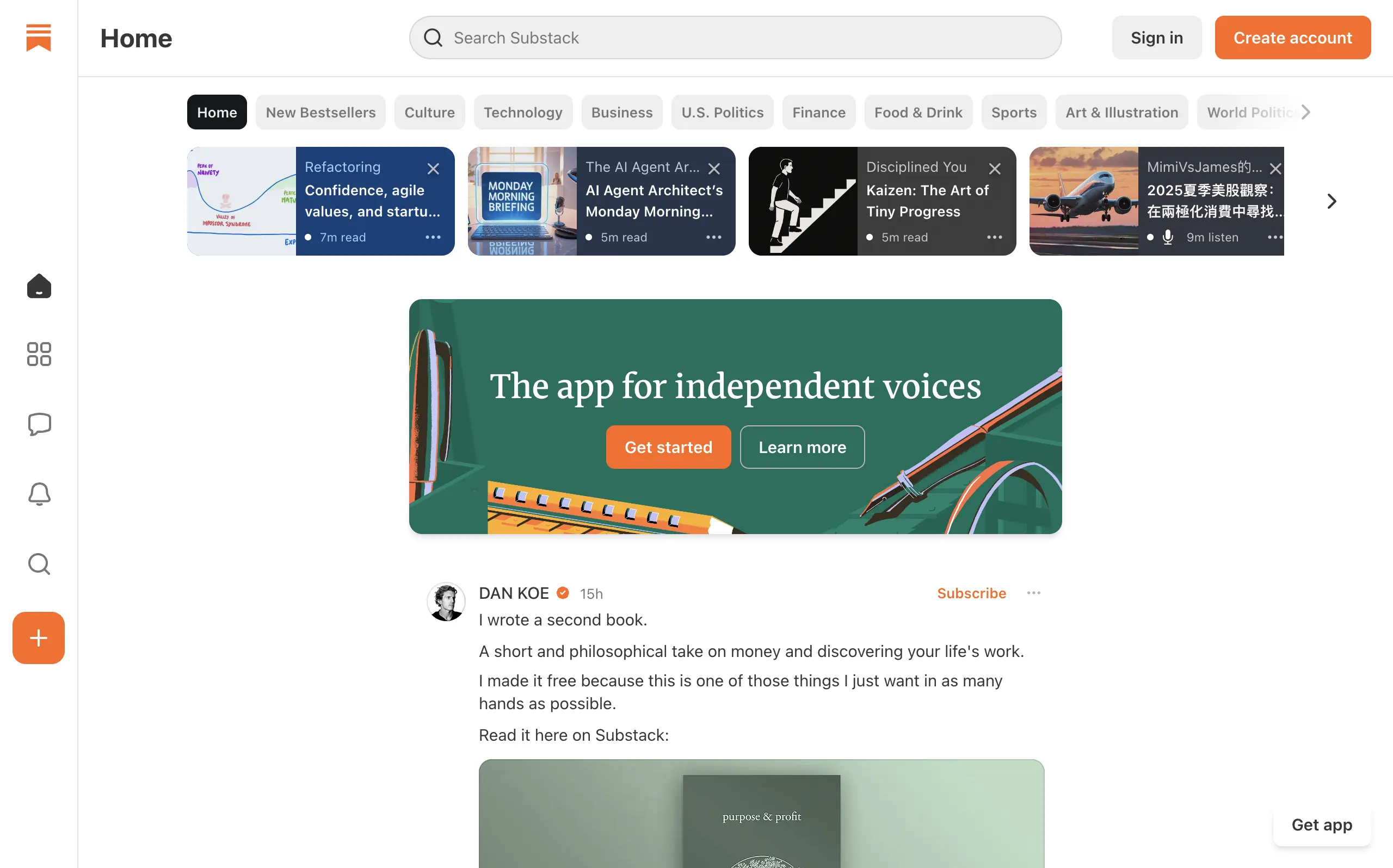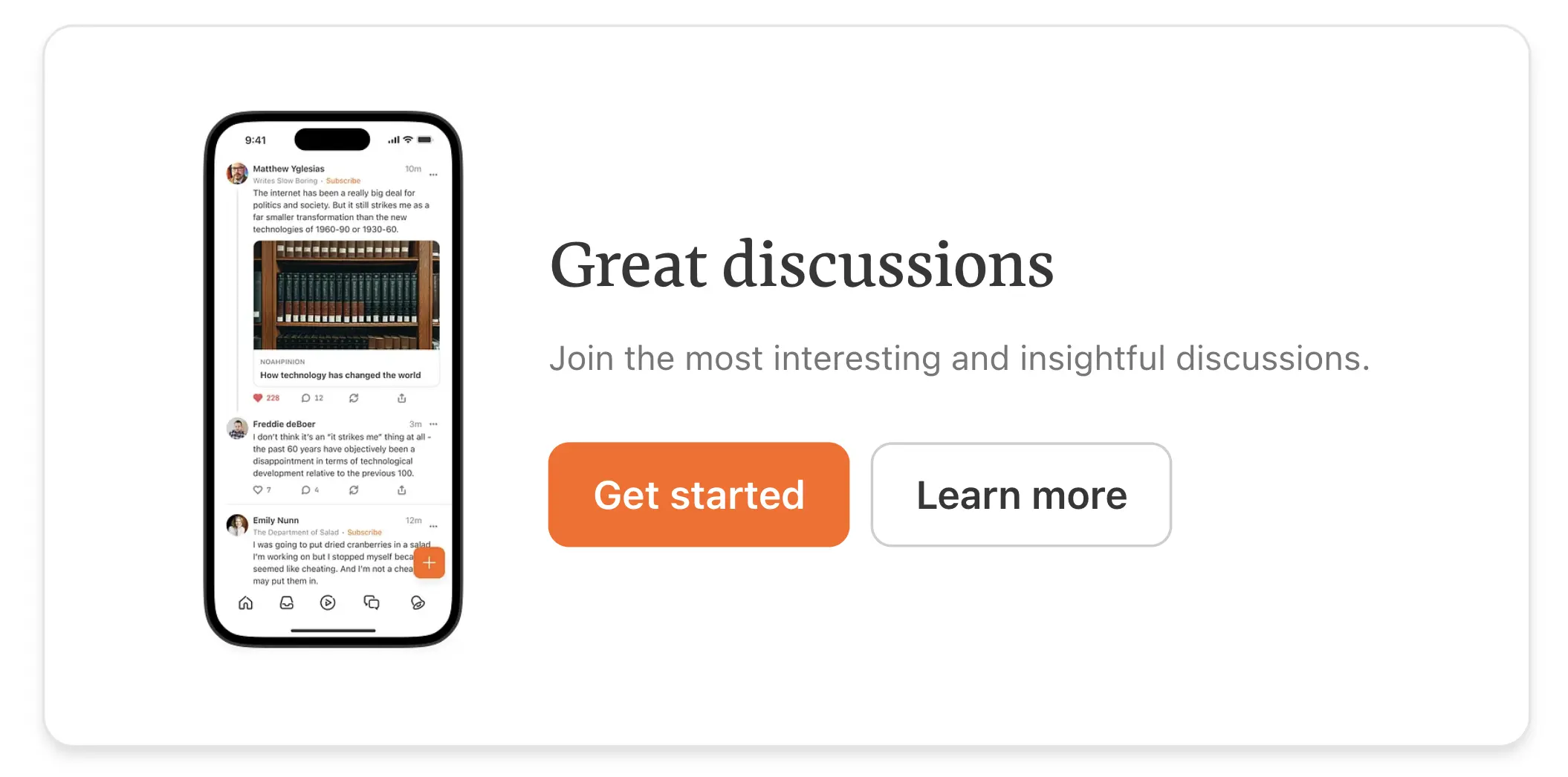Substack’s Creator Economy: 7 Insights on 50M Users, 5M Paid
Discover how Substack empowers creators to monetize content with 50 million users and 5 million paid subscribers, reshaping the creator economy through a DTC model.
- Carrie
- 7 min read

Recently, I’ve been diving into a platform called Substack, and it feels like there’s a lot worth exploring behind it.
If you’re intrigued by content creation in the digital age or curious about earning rewards through your writing, Substack’s story might spark some inspiration.
What is Substack?
In the simplest terms, Substack is an upgraded email newsletter platform.
It enables writers to easily create and publish content, earning income directly from readers who value their work through paid subscriptions.
However, Substack is more than just a newsletter platform—it’s a movement that empowers writers, reshaping the content ecosystem.
Platform Overview
Substack, founded in 2017 by Chris Best, Jairaj Sethi, and Hamish McKenzie, has a straightforward mission: to provide writers with an intuitive platform to create and publish paid email newsletters, earning revenue directly from their audience.
Substack bypasses traditional media gatekeepers—editors, advertisers, and complex algorithms—handing content control back to creators. Writers own their subscriber lists, set their own subscription prices (with free content options), and the platform earns by taking a 10% cut of subscription fees.
At its core, this model thrives on trust and value exchange: readers subscribe because they trust creators to deliver valuable content consistently, while creators, with stable income, focus on producing high-quality work.

User Scale
Since its inception in 2017, Substack’s user base has grown significantly.
Early on, its unique model and creator-friendly policies attracted prominent journalists, authors, and thought leaders, creating a strong headliner effect.
The global pandemic further accelerated growth, as remote work and digital content consumption surged, drawing writers displaced by media layoffs or seeking greater autonomy to the platform.
Key data points from recent public information include:
- Active Subscribers: As of March 2025, Substack’s website reports over 50 million active subscribers (including free and paid).
- Paid Subscribers: By March 2025, the platform surpassed 5 million paid subscribers.
- Creator Earnings: According to Reddit discussions citing late 2024 data, the top 10 creators collectively earn over $40 million annually. With over 50,000 creators, the platform generates an economic value of approximately $300–400 million.
- Platform Revenue: Substack earns a 10% commission on subscription revenue, plus Stripe’s payment processing fees (2.9% + $0.30 per transaction). In 2021, platform revenue was about $11.9 million; in 2022, it grew 58% to roughly $19 million; GrowJo estimated $21.3 million in 2023 (unconfirmed). Based on user growth, 2024–2025 revenue is projected at $30–40 million.
Substack has undeniably built a vibrant creator-subscriber ecosystem, proving the viability of creators charging readers directly and fostering a wave of “digital solopreneurs” achieving financial freedom through writing.
Why Do People Use Substack?
Let’s explore this from the perspectives of creators and readers.
For Creators
Creative Autonomy: Creators can freely choose their topics and express their views without catering to traditional media’s editorial policies or commercial pressures, focusing on their passions and expertise to share authentic, independent perspectives.
Direct Financial Rewards: Effort translates directly into income. High-quality content attracts more paid subscribers, offering substantial and sustainable earnings—a major incentive for writers reliant on meager freelance fees or unstable gigs.
Ownership of Audience Data: Substack grants creators access to their subscriber email lists, a rare and valuable asset. This openness reassures creators, as they can retain their core audience even if they switch platforms.
Low Technical Barriers: The platform handles website setup, payment processing, and email delivery, freeing creators to focus solely on content creation.
Building Personal Brand and Influence: Consistent, valuable content helps creators establish a personal brand and industry influence, becoming true thought leaders.
Escaping the “Traffic Trap”: Unlike platforms reliant on algorithms and ad clicks, Substack encourages creators to attract and retain readers with meaningful content, prioritizing depth over chasing trends.

For Readers
- High-Quality, Curated Content: In an era of information overload, paid subscriptions offer access to carefully curated, often deeper, and more professional content.
- Directly Supporting Creators: Subscriptions allow readers to fund the writers they admire, enabling continued creation.
- Ad-Free Reading Experience: Substack’s subscription-driven model delivers a clean, immersive reading environment, free from ads.
- Niche Expertise: Many Substack newsletters cover specialized topics overlooked by mainstream media, catering to readers’ specific interests.
- Community Connection: Features like comments and discussion threads foster interaction among readers, creators, and like-minded individuals, building a sense of community.
I particularly admire Substack’s ad-free reading experience and its effort to restore creative control to writers.
Compared to many corporate “content ecosystems”—often riddled with irrelevant information, intrusive ads, or restrictive algorithms—Substack stands out. You know who I’m talking about.
Reflections on Substack
Studying Substack reveals deeper insights into the creator economy’s logic and trends, which I find profoundly thought-provoking.
1. The Practical Value of the “1000 True Fans” Theory
Kevin Kelly’s “1000 True Fans” theory posits that creators can sustain a decent living with 1,000 loyal fans paying, say, $100 annually. Substack’s data strongly validates this idea.
A Substack creator doesn’t need millions of followers like a mega-influencer but rather a few thousand to tens of thousands of loyal paid subscribers. For instance, a creator with 2,000 subscribers paying $5 monthly can earn $120,000 annually (before platform fees).
Take Dan Koe, a “solopreneur” I’ve been researching. With 110,000 Substack subscribers and an estimated 10% conversion rate (10,000 paid subscribers) at $150 annually, he could generate $1.5 million yearly. After a 15% deduction for platform and transaction fees, his net income is roughly $1.27 million—a remarkable figure.

This suggests creators don’t need a mass market but can succeed by serving a niche, highly engaged audience. The small but mighty business model seems genuinely viable.
2. The Feasibility of Paid Content and Value Recognition
We’ve grown accustomed to free internet content, but Substack’s success has made me rethink paid content.
When content is unique, insightful, or offers scarce value—such as expert industry analysis, exclusive insights, profound reflections, or distinctive experiences—users are willing to pay.
This signals a renewed recognition of content’s intrinsic value, moving beyond clicks and ad impressions.
3. The Immense Potential of Niche Markets
Substack hosts numerous newsletters covering specialized industries, subcultures, skills, or personal interests. Notably, even “obscure” or “niche” topics can attract enough paid subscribers to sustain creators.
This underscores the internet’s long-tail effect in content. Needs once overlooked by mainstream media now find fulfillment on platforms like Substack.
4. Applying the DTC Model in Content
The DTC (Direct-to-Consumer) model involves selling directly to end consumers, like independent e-commerce sites versus Amazon or Tmall.
Substack is fundamentally a DTC platform for content creators.
It reduces reliance on traditional publishers or media platforms, allowing creators to connect directly with their audience, own user data (primarily email lists), and foster direct communication and feedback.
This model grants creators unprecedented autonomy and flexibility, shifting user relationships from platform-owned to creator-owned, crucial for building long-term, stable connections.
5. Trust as the Core of the Creator Economy
In an era of questionable information, confusing algorithms, and AI-generated content, trust in a creator’s expertise, values, or unique style is increasingly vital.
Readers subscribe to a Substack because they trust and value the creator. Building this trust requires consistent, high-quality, and authentic content.
Personal branding and the trust it fosters are becoming more critical than platform algorithms.
6. The Matthew Effect and Challenges in the Creator Economy
While Substack has opened doors for many, challenges persist.
Top creators capture most of the platform’s revenue, reflecting a clear Matthew Effect. For new or lesser-known creators, achieving initial traction and subscribers remains a hurdle.
The platform’s recommendation system and content discovery mechanisms are vital for a healthy ecosystem. Creators also need self-promotion and marketing skills. Success isn’t guaranteed—consistent quality content and effective community engagement are key.
7. Content Format Convergence and Expansion
Substack has evolved from text-only newsletters to supporting podcasts, videos (via embeds), discussion threads, and short updates. Creators are increasingly experimenting with multimedia to diversify expression and meet varied user preferences.
Video content has surpassed text in some contexts, with platforms like TikTok thriving on short-form videos. YouTube, the second-largest traffic source after search engines, enables some creators to earn substantial income through ad revenue.
Future content creation will likely be more diverse and integrated. Creators must adapt, choosing mediums and platforms that suit their strengths to deliver varied content and services.
Final Thoughts
Substack’s growth, with 50 million subscribers converting 5 million into paid users, yields a 10% conversion rate.
This can be seen as a benchmark for content monetization, roughly 10%.
If you’re a content creator, ask yourself:
- How many subscribers do you currently have? Think of this as your fan base or reachable audience.
- At a 10% conversion rate, how many could become paid subscribers?
- If you’ve launched a paid model, are you hitting 10% conversion?
If your conversion rate falls below this benchmark, your paid content or services may lack sufficient value to compel payments, or you haven’t reached the right audience.
If you’re exceeding 10%, congratulations! You’re on track to become a top creator. Consider enhancing content quality or raising prices for even greater returns!
- Tags:
- Software